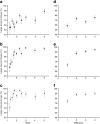Representational format determines numerical competence in monkeys
- PMID: 21448156
- PMCID: PMC3072099
- DOI: 10.1038/ncomms1262
Representational format determines numerical competence in monkeys
Abstract
A range of animal species possess an evolutionarily ancient system for representing number, which provides the foundation for simple arithmetical operations such as addition and numerical comparisons. Surprisingly, non-human primates tested in ecologically, highly valid quantity discrimination tasks using edible items often show a relatively low performance, suggesting that stimulus salience interferes with rational decision making. Here we show that quantity discrimination was indeed significantly enhanced when monkeys were tested with inedible items compared with food items (84 versus 69% correct). More importantly, when monkeys were tested with food, but rewarded with other food items, the accuracy was equally high (86%). The results indicate that the internal representation of the stimuli, not their physical quality, determined performance. Reward replacement apparently facilitated representation of the food items as signifiers for other foods, which in turn supported a higher acuity in decision making.
Figures


Similar articles
-
Impact of stimulus format and reward value on quantity discrimination in capuchin and squirrel monkeys.Learn Behav. 2018 Mar;46(1):89-100. doi: 10.3758/s13420-017-0295-9. Learn Behav. 2018. PMID: 28840526
-
Does the stimulus type influence horses' performance in a quantity discrimination task?Front Psychol. 2012 Nov 16;3:504. doi: 10.3389/fpsyg.2012.00504. eCollection 2012. Front Psychol. 2012. PMID: 23181043 Free PMC article.
-
Acquisition of object-robbing and object/food-bartering behaviours: a culturally maintained token economy in free-ranging long-tailed macaques.Philos Trans R Soc Lond B Biol Sci. 2021 Mar;376(1819):20190677. doi: 10.1098/rstb.2019.0677. Epub 2021 Jan 11. Philos Trans R Soc Lond B Biol Sci. 2021. PMID: 33423623 Free PMC article.
-
Understanding of and reasoning about object-object relationships in long-tailed macaques?Anim Cogn. 2013 May;16(3):493-507. doi: 10.1007/s10071-012-0591-x. Epub 2013 Feb 17. Anim Cogn. 2013. PMID: 23417558 Free PMC article.
-
Capuchin monkeys (Cebus apella) treat small and large numbers of items similarly during a relative quantity judgment task.Psychon Bull Rev. 2016 Aug;23(4):1206-13. doi: 10.3758/s13423-015-0986-1. Psychon Bull Rev. 2016. PMID: 26689808 Free PMC article.
Cited by
-
Old world monkeys compare to apes in the primate cognition test battery.PLoS One. 2012;7(4):e32024. doi: 10.1371/journal.pone.0032024. Epub 2012 Apr 2. PLoS One. 2012. PMID: 22485130 Free PMC article.
-
Monkeys perform as well as apes and humans in a size discrimination task.Anim Cogn. 2013 Sep;16(5):829-38. doi: 10.1007/s10071-013-0616-0. Epub 2013 Feb 27. Anim Cogn. 2013. PMID: 23443407 Free PMC article.
-
The culture of social comparison.Proc Natl Acad Sci U S A. 2018 Sep 25;115(39):E9067-E9074. doi: 10.1073/pnas.1721555115. Epub 2018 Sep 10. Proc Natl Acad Sci U S A. 2018. PMID: 30201717 Free PMC article.
-
Does quantity matter to a stingless bee?Anim Cogn. 2022 Jun;25(3):617-629. doi: 10.1007/s10071-021-01581-6. Epub 2021 Nov 23. Anim Cogn. 2022. PMID: 34812987 Free PMC article.
-
Long-tailed macaques (Macaca fascicularis) can use simple heuristics but fail at drawing statistical inferences from populations to samples.R Soc Open Sci. 2018 Sep 12;5(9):181025. doi: 10.1098/rsos.181025. eCollection 2018 Sep. R Soc Open Sci. 2018. PMID: 30839652 Free PMC article.
References
-
- Dehaene S. The Number Sense (Oxford University, 1997).
-
- Feigenson L., Dehaene S. & Spelke E. Core systems of number. Trends Cogn. Sci. 8, 307–314 (2004). - PubMed
-
- Nieder A. Counting on neurons: the neurobiology of numerical competence. Nat. Rev. Neurosci. 6, 177–190 (2005). - PubMed
-
- Ward C. & Smuts B. B. Quantity-based judgments in the domestic dog (Canis lupus familiaris). Anim. Cogn. 10, 71–80 (2007). - PubMed
-
- Pisa P. E. & Agrillo C. Quantity discrimination in felines: a preliminary investigation of the domestic cat (Felis silvestris catus). J. Ethol. 27, 289–293 (2009).
Publication types
MeSH terms
LinkOut - more resources
Full Text Sources

